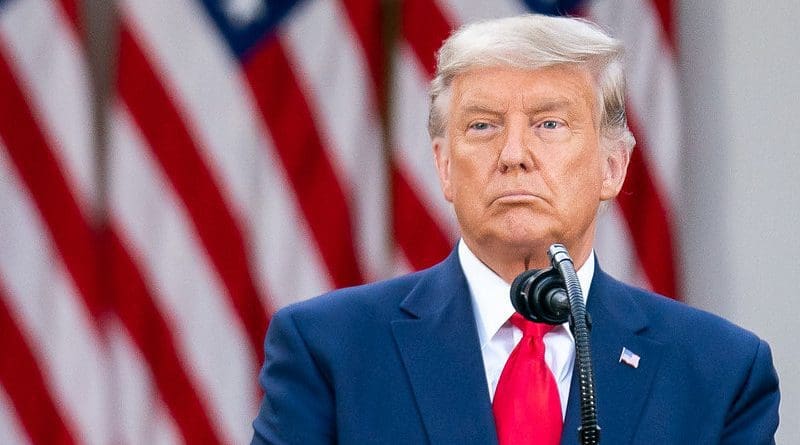Trump’s Legacy And The Future Of The GOP – OpEd
The days of the Trump administration are winding down. His lawsuits contesting the outcome of the 2020 election have gone nowhere. Despite Trump’s impressive total of 74,223,744 votes, Joe Biden (with the help of the media) beat him. It’s time to take a look at what many call “Trumpism” and think of the future.
As an initial matter, who would ever have believed that when he descended the escalator of Trump Tower on June 16, 2015, that Donald Trump had a chance to become the president? Jeb Bush or Marco Rubio was supposed to face off with Hillary Clinton in the 2016 election. Sen. Lindsey Graham, as he watched the voters embrace Trump, averred that “My party has gone batshit crazy.”
In a sense, the people did go crazy—crazy for an opportunity to vote for someone who had ideas different from Democrats. The post–Cold War GOP was in agreement with the Democrats on issues such as trade, immigration, and foreign policy. The parties pretended to have disagreements of fiscal matters, with the GOP calling for tax cuts and the Democrats for higher rates on the rich. All the while only about 35 percent of the budget was discretionary spending. The bulk of the budget (military spending, entitlements, interest payments, and so forth) was and is on autopilot.
Trump tapped into Middle American dissatisfaction with trade policy and an “invite the world / invade the world” immigration and foreign policy. During 2016 primary debates, he was the only Republican candidate on stage to challenge the orthodoxy that George W. Bush’s decision to invade Iraq and topple Saddam Hussein was heroic. Trump said it was disastrous. Little Marco and Jeb could only stand there with mouths agape.
Middle Americans, tired of seeing factories close and move overseas, concerned that the flow of people from our southern border was becoming a flood, and missing sons and daughters suffering long deployments to the Middle East, found a champion in Trump. He was offering alternative policy proposals on issues that mattered to them.
Did Trump have warts? Absolutely. Stormy Daniels, a potty mouth, narcissism, embarrassing tweets, a personality that was anything but statemanesque. But the people didn’t seem to care. They were desperate for something different than a Romney-Ryan GOP, a party that had more in common with the Democrats than the average Republican voter.
Trump did the unthinkable. He won 30 states, including the “blue wall” of Michigan, Pennsylvania and Wisconsin, which had been Democratic gimmes for decades. Hillary’s coronation was canceled.
Whether it was from political inexperience or stupidity, Trump proceeded to staff the White House and other positions with individuals who would have been a perfect fit for a Romney-Ryan administration. Nikki Haley to the UN, Mike Pompeo as director of the CIA and later Secretary of State, and eventually John Bolton as national security advisor. Not a team to have in place if you are pursuing an America First agenda.
This misstep, coupled with constant attacks from the media and political opponents (Russiagate, impeachment, etc.) incensed that Hillary Clinton was not president, made it difficult for Trump to deliver on many of his promises. Nonetheless, he did manage to avoid additional foreign wars (Hawks had eyes on Iran) and has reduced the number of American forces in Iraq, Afghanistan, and Somalia. Trump has built 423 miles of border wall, but this is a small fraction portion of the boarder with Mexico. Folks are still arguing whether the tariffs (imposed on 16.8% of all imported goods) will, in the long-run, help or hurt the U.S. economy. The economy was humming along pretty well before COVID-19 and state lockdowns knocked the engine from the tracks.
Undoubtedly, establishment GOP leaders hope to go back to a Romney-Ryan Republicanism and pretend that Donald Trump never happened. Will Middle America let them do it? Only if the Republicans accept that they will never win the presidency for the foreseeable future. While this analysis from 2016 is dated, the point remains: the GOP candidate is and will continue to be an underdog in a presidential race. The path to victory is easier for a Democrat than a Republican. The GOP has to recreate something of the 2016 electoral map, and to do so it needs the rust-belt states that Trump flipped in 2016.
Abandoning the issues that appealed to Middle Americans in 2016 for Romney-Ryan Republicanism is not the answer. Rightly or wrongly, Middle Americans believed that Trump cared about them and their issues. Exit polls for 2020 showed that concerns over COVID and the media’s constant bashing of Trump’s COVID policy probably killed Trump’s momentum in the blue-wall states he won the previous election. But for the pandemic, the outcome of the 2020 election likely would have been different.
Bottom line: The GOP needs Middle Americans to be excited about their candidate and to vote in large numbers. This will only happen if GOP leadership can put aside its hatred for Trump and examine why the bully from New York City excited the electorate in 2016, and even in defeat in 2020, won 74 million votes.
This article was published by The Beacon

